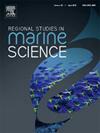台湾利尔湖欧洲鳗鲡(Anguilla Anguilla)鱼鳔寄生虫入侵的发生
IF 2.1
4区 环境科学与生态学
Q3 ECOLOGY
引用次数: 0
摘要
本研究调查了本文章由计算机程序翻译,如有差异,请以英文原文为准。
Occurrence of the invasive swim bladder parasite Anguillicola crassus in European eels (Anguilla anguilla) in Güllük Lagoon, Türkiye
In the present study, the prevalence, mean intensity, and abundance of the nematode parasite Anguillicola crassus were investigated for European eels caught in the Güllük Lagoon, Muğla, Türkiye. Additionally, prevalence, mean intensity, and abundance data were examined for the data published from other European eel habitats in Türkiye. The same data was used to analyze the variations between freshwater and brackish water habitats. The first published research on A. crassus infestations was reported from the Ceyhan River (Türkiye) in 2005. 120 adult (sexually differentiated) Anguilla anguilla were collected between June 2023 and May 2024. Ten specimens were collected monthly to determine seasonal variations of A. crassus infection. During the study period, A. crassus was observed in all months except August 2023, March 2024, and April 2024. 14 % of the eels were found to be infected by A. crassus. Mean prevalences were 13.33 % ± 15.28, 20.0 % ± 10.0, 20.0 % ± 10.0, and 3.33 % ± 5.77 in summer, autumn, winter, and spring, respectively. Statistically significant differences were found for the prevalence data between spring-autumn (Mann-Whitney U = 0.5, p < 0.05) and spring-winter. Mean abundances in all samples were 1.63 ± 1.60, 3.63 ± 1.76, 2.80 ± 1.76, and 1.17 ± 2.02 for summer, autumn, winter, and spring, respectively. Mean intensities in all samples were 9.23 ± 8.59, 18.23 ± 4.13, 13.07 ± 4.78, and 11.67 ± 20.21 for summer, autumn, winter, and spring, respectively. There were no statistical differences between all seasons for abundance and mean intensity. A. crassus infestation was low in abundance and prevalence and probably affects the eel population less than in other habitats. However, in terms of mean intensity, it is suggested that it may cause stress in the life of infected eels individually, during the silvering process, and migration.
求助全文
通过发布文献求助,成功后即可免费获取论文全文。
去求助
来源期刊

Regional Studies in Marine Science
Agricultural and Biological Sciences-Ecology, Evolution, Behavior and Systematics
CiteScore
3.90
自引率
4.80%
发文量
336
审稿时长
69 days
期刊介绍:
REGIONAL STUDIES IN MARINE SCIENCE will publish scientifically sound papers on regional aspects of maritime and marine resources in estuaries, coastal zones, continental shelf, the seas and oceans.
 求助内容:
求助内容: 应助结果提醒方式:
应助结果提醒方式:


